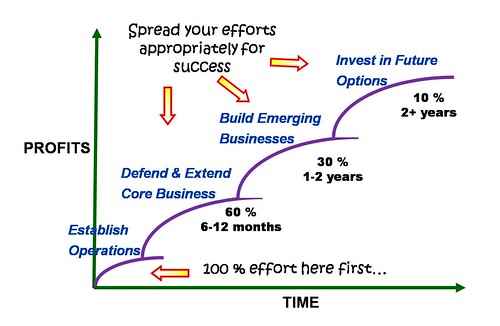Understandable & Effective Business Strategy
Business strategy is often one of those things talked about in an executive office, but often not taken out to the organization (large or small). Whether it is so complex that only executives can understand it or the perception that is too complex to communicate by those developing it varies, however strategy works best when everyone is aware of it and understands it. Not everyone can or should participate in developing it, but execution works best when everyone is driving towards the strategic goal.
Even the term strategy congers up advanced diagrams, and complex thinking, that scares many in a company to leave it to the leaders in the organization. This is also wrong. Business strategy doesn't have to be complex.
Here is a simple model that can be used to communicate strategy to the organization that is simple but effective for both large and small organizations. Startups especially, can use this to help the team think about something beyond the current month or what will happen after the beta release. If you become a market leader in a new space, you still need to be thinking about the day when your differentiation will be copied or 'commoditized'.
The model works on the simple principal of always thinking ahead. Of course if you are a startup, you initially need to be focused on getting something to market. This required focus and some thinking about market segment targeting. However once you have went to market, there are 3 key curves in which you should be thinking about.
Defend and Extend: This is the hear and now. Many companies spend their entire effort in this curve, only to be surprised by the competition, and forced into a commodity market, which is a losing battle. Spend 60 % of your effort in this curve at any given time. This is your sweet spot and where the business makes the majority of its money. For most companies in the current competitive environment, you should assume this will be a 6-12 month window.
Build Emerging Businesses: Emerging business's are in the 1-2 year time horizon. This is the next big offering that will keep your business on top, once your current cash cow is a commodity. You should be spending about 30% of your efforts in this space, so that when the time is right, these offerings will become your core business.
Invest in Future Options: Future options are in the 2+ year horizon. This is your companies R&D. It is especially important for services businesses, as it is often forgotten. You want about 10% of your effort in this space right now. If you are a startup, this could be as simple as getting the team together for drinks after work and coming up with a few ideas on where your product could get to. The key point is to be thinking about it. As your emerging business becomes your core, so to does your best R&D item become your next emerging business option, and so the cycle continues.
I have found that this is a simple and effective strategy model that can work in large organizations down to a bootstrapping startup. It is a simple effective visual that gets people thinking the right way about sustaining your business, and can be easily communicated.
No comments:
Post a Comment